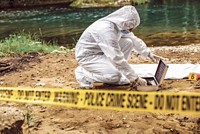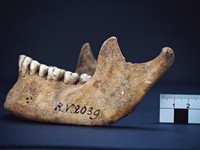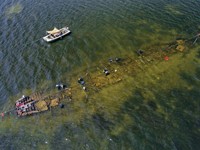Advertisement
Grab your lab coat. Let's get started
Welcome!
Welcome!
Create an account below to get 6 C&EN articles per month, receive newsletters and more - all free.
It seems this is your first time logging in online. Please enter the following information to continue.
As an ACS member you automatically get access to this site. All we need is few more details to create your reading experience.
Not you? Sign in with a different account.
Not you? Sign in with a different account.
ERROR 1
ERROR 1
ERROR 2
ERROR 2
ERROR 2
ERROR 2
ERROR 2
Password and Confirm password must match.
If you have an ACS member number, please enter it here so we can link this account to your membership. (optional)
ERROR 2
ACS values your privacy. By submitting your information, you are gaining access to C&EN and subscribing to our weekly newsletter. We use the information you provide to make your reading experience better, and we will never sell your data to third party members.
Forensic Science
Bone proteins may carry clues about how a body was buried
Decay rates differ inside wooden coffins underground and zinc-lined ones in mausoleums, forensic research suggests
by Carolyn Wilke, special to C&EN
March 24, 2022

Forensic scientists have been on a quest for more reliable ways to estimate time of death and age of death from skeletal remains. A new study finds that burial methods influence the protein population in bones, possibly due to the microbes that have access to a decomposing body (J. Proteome Res. 2022, DOI: 10.1021/acs.jproteome.1c00904). Researchers hope to someday use these protein biomarkers to estimate more accurately when a person has died.
Analysis of the proteins found in bones—in combination with microbiome and anthropological research on human remains—could finally clarify the role of microbes in wearing down skeletons, says Paola A. Magni, a forensic scientist at Murdoch University who was not part of this work. That process of decay has been debated for decades, she says. For one, researchers don’t agree on whether the microbes that degrade the body come from the soil or the body’s own gut.
In the new study, researchers analyzed bits of femur from 14 individuals that had been laid to rest either in wooden coffins buried in the ground or in zinc-lined coffins placed in mausoleums. The researchers identified 20 proteins whose levels differed depending on the burial environment. Sixteen of those were more abundant in bodies in zinc-lined coffins. The enclosed environment of the zinc-lined coffins seemed to better preserve proteins, especially those connected to the bones’ mineral matrix, says study coauthor Noemi Procopio, a forensic scientist and molecular biotechnologist at Northumbria University and a UK Research and Innovation Future Leaders Fellow.
Biomarkers like these proteins could help determine the conditions a body has encountered after death. Procopio’s team accessed the bone samples after a separate, court-ordered genetic analysis required the bodies to be exhumed from a cemetery in Italy.
Procopio and her team also found two proteins whose levels correlated with their donor’s age and time since death, but that didn’t vary with burial condition. One of them, albumin, is among the most abundant bone proteins, while the other, fetuin-A, plays a role in mineralizing bones.
These bones, untreated and sourced from a cemetery, represent real forensic samples, Magni says. Validating the results of this study could help researchers develop models to estimate time since death and age at death and account for the burial environment, she says.
Procopio’s team hopes to someday sample bodies’ microbiomes and analyze how the different microbes shift the bone proteome. In zinc-lined coffins, whose insides are isolated from the environment, anaerobic gut microbes “really have fun” and do most of the decomposition, Procopio says. In wooden coffins, which eventually break down, aerobic microbes from the soil would likely replace the gut microbes, resulting in faster decomposition and differences in the population of bone proteins.





Join the conversation
Contact the reporter
Submit a Letter to the Editor for publication
Engage with us on Twitter